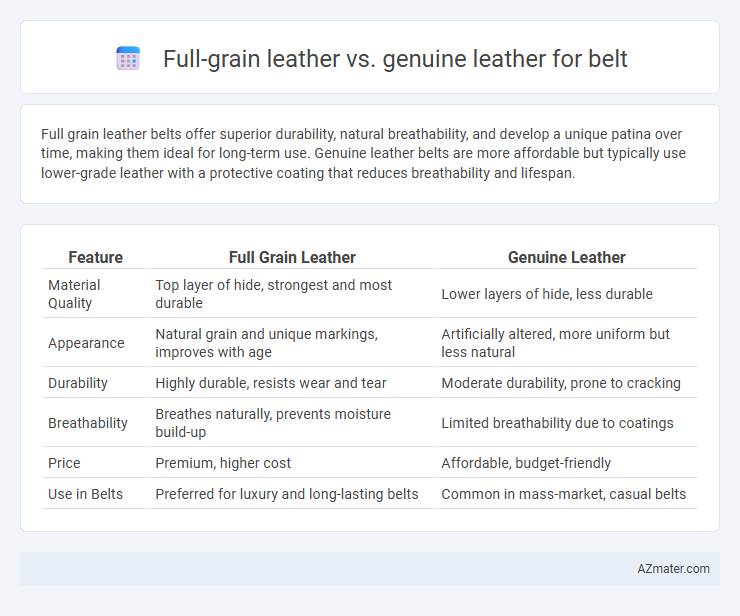Full grain leather belts offer superior durability, natural breathability, and develop a unique patina over time, making them ideal for long-term use. Genuine leather belts are more affordable but typically use lower-grade leather with a protective coating that reduces breathability and lifespan.
Table of Comparison
| Feature | Full Grain Leather | Genuine Leather |
|---|---|---|
| Material Quality | Top layer of hide, strongest and most durable | Lower layers of hide, less durable |
| Appearance | Natural grain and unique markings, improves with age | Artificially altered, more uniform but less natural |
| Durability | Highly durable, resists wear and tear | Moderate durability, prone to cracking |
| Breathability | Breathes naturally, prevents moisture build-up | Limited breathability due to coatings |
| Price | Premium, higher cost | Affordable, budget-friendly |
| Use in Belts | Preferred for luxury and long-lasting belts | Common in mass-market, casual belts |
Introduction to Leather Types for Belts
Full grain leather for belts retains the natural surface and markings, offering superior durability, aging beauty, and breathability, making it the highest quality leather option. Genuine leather, often made from lower layers and corrected surfaces, is more affordable but less durable and prone to wear and creasing over time. Choosing full grain leather ensures a belt that strengthens with age, while genuine leather suits budget-conscious buyers seeking style without maximum longevity.
What is Full Grain Leather?
Full grain leather is the highest quality leather, made from the top layer of the hide, retaining all natural grain and markings. It is more durable, develops a rich patina over time, and is highly breathable compared to genuine leather, which is often corrected and split from lower layers. Full grain leather belts offer superior strength and longevity, making them an excellent choice for premium and long-lasting accessories.
What is Genuine Leather?
Genuine leather refers to leather made from the lower layers of animal hide, often resulting from the leftover parts after higher-quality sections like full grain are removed. It undergoes extensive processing, including buffing and surface treatment, which reduces its natural texture and durability compared to full grain leather. While genuine leather belts are more affordable, they typically lack the strength, breathability, and aging qualities that full grain leather belts offer.
Full Grain Leather: Key Characteristics
Full grain leather boasts the highest quality and durability among belt materials, retaining the natural grain and strength of the hide which enhances its resistance to wear and tear. Its surface develops a unique patina over time, adding character and visual appeal that genuine leather lacks due to its corrected grain and lower durability. This premium material is prized for breathability, moisture absorption, and long-lasting comfort, making it the top choice for luxury and everyday belts.
Genuine Leather: Key Characteristics
Genuine leather, derived from the lower layers of the hide, features a smooth surface often treated with coatings to enhance its appearance and durability for belts. It provides a cost-effective option with moderate durability but lacks the natural grain texture and breathability found in full grain leather. This type of leather is commonly used in fashion belts where affordability and uniformity in color and finish are key considerations.
Durability Comparison: Full Grain vs Genuine Leather
Full grain leather exhibits superior durability compared to genuine leather due to its intact natural grain layer, which offers enhanced resistance to wear and tear. Genuine leather, made from lower-quality leather layers bonded together, tends to be less durable and shows signs of damage like cracking and peeling more quickly. For long-lasting belts, full grain leather remains the preferred choice due to its strength and ability to develop a unique patina over time.
Appearance and Aging: How Each Leather Evolves
Full grain leather maintains its natural surface with visible grain patterns and develops a rich patina over time, enhancing its appearance and uniqueness. Genuine leather, often corrected and treated, tends to have a uniform look but may lose its finish or develop surface cracks as it ages. The aging process in full grain leather results in increased softness and a luxurious, antique look, while genuine leather typically shows wear and deterioration faster, impacting its overall aesthetic appeal.
Price Differences and Value for Money
Full grain leather belts typically command higher prices due to their durability, natural texture, and aging potential, making them a long-term investment. Genuine leather belts are more affordable but often consist of lower-quality layers or bonded leather, which compromises longevity and aesthetic appeal. Choosing full grain leather provides significantly better value for money as it combines premium craftsmanship with extended wear resilience.
Best Use Cases: Which Leather Suits Your Needs?
Full grain leather is ideal for high-quality belts due to its durability, natural texture, and ability to develop a rich patina over time, making it perfect for formal wear and everyday use. Genuine leather, being more affordable and less durable, suits fashion belts or casual wear where budget and style variety are prioritized over longevity. Choosing full grain leather ensures long-term performance and a premium look, while genuine leather offers versatility and cost-effectiveness for less demanding applications.
Final Verdict: Choosing the Right Leather for Your Belt
Full grain leather offers superior durability, natural texture, and ages beautifully, making it ideal for high-quality belts that last years. Genuine leather, often made from lower-grade layers, provides an affordable and consistent appearance but lacks the strength and patina development of full grain. Choosing full grain leather ensures a premium belt with long-term value, while genuine leather suits budget-conscious buyers seeking a polished look.

Infographic: Full grain leather vs Genuine leather for Belt
 azmater.com
azmater.com